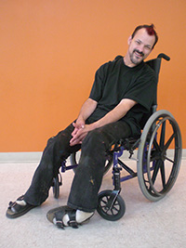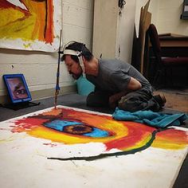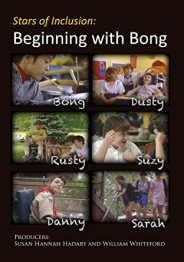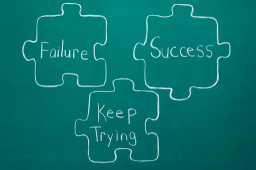The artist Dan Keplinger creates his work with the use of a headstick. Keplinger and his work are featured in the Oscar-winning documentary, King Gimp. He holds a BA in Mass Communication and Art and an MFA in Studio Art from Towson University.


Images courtesy of Dan Keplinger
Some people know me as Dan Keplinger, others as King Gimp; but they both stand for loyalty, honesty and a fighting spirit.
Interview of January 4, 2019
Alexandra Wang: Because you were able to push yourself to the top of hills in your wheelchair, your neighbors called you King Gimp. What made you decide to adopt that name in your personal and professional life?
Dan Keplinger: I always liked it. But I really adopted it after I did a long definition assignment in the 12th grade. We had to pick a word, look at it and write about it.
I chose ‘king’ and found one of the meanings was ‘fighting spirit.’ Funny thing is, I never have been able to find the same definition since. So, maybe I made an urban legion. I also had a few people tell me that Gimp was one of Jesus’s Apostles who was unknown. I once even asked a Biblical scholar, but he looked puzzled.
Alexandra Wang: How were you able to turn a word like ‘gimp’ into something positive?
Dan Keplinger: This is about taking control of the situation and making it work for you. I look at my disability as a part of my personality. So, I fully embrace it for the good and the bad. You need to turn the bad around, so it makes you better as a person.
I look at my disability as part of my personality. So, I fully embrace it for the good and the bad.
Alexandra Wang: What would your advice be for others to turn those kind of words into something positive?
Dan Keplinger: Find your passion in life. That passion is a seed to goals and dreams. You will do anything to reach your dreams!


Image courtesy Cerebral Palsy.org Image courtesy ABILITY Magazine
https://www.youtube.com/watch?v=_DIwQTFbn1g
Alexandra Wang: How can art be a place of passion for people with Cerebral Palsy (CP?)
Dan Keplinger: Art is its own language; there are no rights, or wrongs. The idea is to have freedom of expression. Nobody can take that away from you.
Art is a place to express your true feelings, no matter what. These feelings could be complete bliss, or could be troubling to others. I do not think art is not merely decorating, but a bridge between different groups to start conversations.
https://www.youtube.com/watch?v=Qz7jisiRsR4&t=4s
Alexandra Wang: How did your art teacher at school initially respond when you started making art?
Dan Keplinger: At first, they really did not know what to do with me. They thought that maybe I could not be in the class. They did not even know if I could understand the assignments, let alone have the ability to do it physically. Ironically, to be a free creative artist, you must first fit in a box to see if you understand the fundamentals. That is what almost kept me from being an artist.
 Image courtesy WeAreTeachers
Image courtesy WeAreTeachers
In my last year of high school, I had four periods of art. I think they knew that I was a hard worker determined to get everything done.
Alexandra Wang: How were you viewed by your peers?
Dan Keplinger: I would like to think they thought of me as a cool geek. After all, I was an artist.
Alexandra Wang: Which artists inspired you in your work as an artist?
Dan Keplinger: I feel like my work needs some narration about what I am trying to express. During my MFA work, I discovered, Philip Guston. He started in NYC with group of Abstract Expressionists, but then broke off to do his own thing. Guston started to developed his own iconography to help tell stories about his own world. As I work with images of wheelchairs or headsticks, I also look at Chuck Close since his work is made up of a lot of marks.


Image courtesy King Gimp-Dan Keplinger Image courtesy King Gimp
Alexandra Wang: Which styles or themes do you enjoy the most?
Dan Keplinger: I like portraits. But a portrait does not need to be an image of the person. I think a portrait can be anything that represents what the person is known for. For example, a wheelchair, or a cup of coffee with a straw in it.
 Image courtesy Dan Keplinger
Image courtesy Dan Keplinger
Alexandra Wang: What is your aim when you give art demonstrations and talks in schools?
Dan Keplinger: I like to do this in a small group setting. This is so the students can really get to know me and ask the questions that they would otherwise be too shy to ask. I hope during this time they get to learn that anything is possible when it becomes a passion.
Anything is possible when it becomes a passion.
Alexandra Wang: What is your reaction when you see other people use their heads, mouths and feet to imitate your style?
Dan Keplinger: This happens a lot in art classes, when a student connects to certain artists. The student is trying to figure out that style of painting, and if it is the right fit for them. Ultimately, the student will adopt it into their own style, or what I call ‘dialect.’ I am always amazed when students say they talk about me in their class. I always think, “that is for a Master Artist; not someone like me.”
 Image courtesy Tyler School of Art- Temple University
Image courtesy Tyler School of Art- Temple University
Alexandra Wang: What about your own life as a student? What were some beliefs you grew up with about Cerebral Palsy and becoming an artist?
Dan Keplinger: I always knew my CP was apart of my personality. It made me who I was. So, why fight it and not embrace the person who I was meant to be? It also gave me a different outlook on life as everything was a challenge to overcome.
Now I look at my CP as a lifestyle. Even though I did not choose this path, compared to the lifestyle of being an artist. It was the path that was fated for me.
Alexandra Wang: Your mother was initially urged to send you to an institution, but refused. What kind of advice from doctors would have been more helpful?
Dan Keplinger: Do not go for the quick and easy answer, every child and family are a unique case. The role of doctors and other professionals is to be there to help the families find the best answers for them. Most of the time, the families will know what works best. So, do not put everyone in the same box.
Alexandra Wang: In addition to King Gimp, you were in a documentary featuring other children with disabilities. What is the link between these two films?
Dan Keplinger: The same producer had a grant to do a documentary on kids who were already mainstreamed in schools. The purpose of the film, Stars of Inclusion: Beginning With Bong, was to show everyone the benefits of mainstreaming students with disabilities. At the time I was still at Ridge School. This is a level 5 special ed school for children with disabilities. So, I should not have been in Stars of Inclusion: Beginning With Bong, since I did not fit the criteria for the film. But the producers saw something special in me.
Over the years they did follow up documentaries on a few of the kids. Every couple of years they would film me too, since I was pushing the limits. Since I could not do interviews, the biggest problem was figuring out how I could tell my story. The producers would send me tapes to screen, and I would write the narrations and thoughts for that footage. I spent two years doing that.
 Image courtesy William Whiteford on Amazon
Image courtesy William Whiteford on Amazon
Alexandra Wang: At age 16, you transferred to Parkville High School, a mainstream school. What could the school and your psychologist have done to help you and your mother?
Dan Keplinger: They could have been more open minded and not so set in their ways. No matter how much education or experience you have, you are always a student. Do not be afraid to try new things, even if you fail. Failure is part of the learning curve and will make you try harder next time.
 Image courtesy John Latham
Image courtesy John Latham
Alexandra Wang: What was transitioning to a mainstream school like for you?
Dan Keplinger: Really, the first week was hell. I do not think they could have not done much more to help me. No matter how much they could have planned, nobody could have known what I really was in for until I just started.
If people thought about everything that could go wrong, it would make people say it was too much of a risk. Now, I compare this time to when I look at a blank canvas.
 Image courtesy Canvas Champ
Image courtesy Canvas Champ
Alexandra Wang: What can school counselors and social workers do to help students with CP?
Dan Keplinger: Listen to students’ dreams and give them the possibility to fulfill them. For four years at my IEP meeting, I would say “I want to make application to a university.” At my IEP meeting in my final year at Parkville they said, “You just will have to go to a community college since you are missing a trigonometry class.” They had three years to tell me this. This one class almost derailed my path.
Listen to students’ dreams and give them the possibility to fulfill them.
Alexandra Wang: How can society support people with disabilities to pursue their dreams?
Dan Keplinger: Just give us chance to show you that we are people too. No matter how small the act is, the whole world will benefit from it.
 Image courtesy March Is National Cerebral Palsy Awareness Month
Image courtesy March Is National Cerebral Palsy Awareness Month
Copyright by Alexandra Wang, 2019. All rights reserved.
![]()